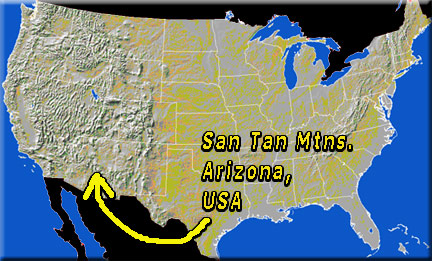|
 Exploring Carter and Kennedy's San Tan Mountainsby Mary Peirce Bale
Exploration of the San Tan Mountains and San Tan Regional Park in Arizona, is intertwined with the lives of Mansel Carter and Marion Kennedy, hermits who chose to live in this wilderness setting 35 miles southeast of Phoenix, Arizona. Conversations with Mansel's sister, Alice, and friends, Ron Hunkler and Betty Nash, shed some light on what drew these hearty men to the San Tans. Mansel hailed from Quaker City, Ohio. In his young adult years, Mansel studied photography, was a pilot, and worked as a logger on the Zuni Indian Reservation in New Mexico. In 1941, he drove to Arizona and he settled in Gilbert where he opened a camera shop. Sometime in the 1940s, Mansel met his future mining partner, Marion Kennedy, a Cherokee Indian from Oklahoma. Marion had attended the Indian School in Carlisle, Pennsylvania with Jim Thorpe. There, he studied geology the structure of the earth and its surfaces. Betty fondly remembered Marion as, "A nice man who never complained about any mistreatment because of his native heritage and he believed in the code of personal responsibility."
Marion use to prowl about when Mansel was off mining. With care, Mansel built a wire fence using cactus stakes as guides so Marion could get around and not fall in the ditch. Marion developed throat cancer and he died in 1960 at age 86. Mansel buried him a short distance from their home.
After Marion's death, Mansel moved into a trailer next to the old shack. Mansel established friendships with many wild creatures that inhabited the area, including a turtle that laid her eggs under his stove. The animals ate food out of his hands. Mansel had visitors from the 50 states and from around the world who wanted to see if he really existed living on the fringe of the material world yet perfectly content in his surroundings. Sometimes local residents who made their way up to see Mansel were rewarded with a taste of, "the most delicious biscuits Mansel made on top of a crude stove", according to Alice.
On a crisp Saturday morning in autumn my husband, Alan, and I decided to explore San Tan Mountain Regional Park. After all, it was only four miles away from our home in Queen Creek. We could see the San Tan range from our back yard. We climbed into our F250 Diesel and we drove down Ellsworth Road to Empire and to the entrance to the Park. As we turned on to Wagon Wheel Road, I imagined I heard the Stagecoach wheels of yesteryear crunching on the gravel. By the time we reached Sundance Road, the scenery mesmerized me. Quail waddled across our path into the desert brush. We parked near the burial site of Goldmine Mountain's reclusive miners Carter and Kennedy. First, we read the tributes on their tombstones before hiking up the mountain saddles. The views of our valley below, the Superstition Mountains and Four Peaks were breathtaking; enhanced by wave-crest cloud formations kissing the peaks all around us. Occasionally, delicious gusts of wind penetrated my sweatshirt that triggered an urge in me to climb over each hump of mountain. Each time I ascended to a different level I was rewarded with spectacular scenes of sky, mountain, and valley. After a recent sky washing the Creote bushes and the Palo Verde trees shimmered with more vibrant greens and baby Saguaro were securing their spots in the rocky, sandy soil.
San Tan Mountain Regional Park is blessed with an abundance of wildlife such as the Desert Cottontail, Javelina, and Mountain Lions. Some of the creepy, crawly reptiles include the Desert Iguana, the Zebra-tailed lizard, the Common King snake, the western Diamondback Rattlesnake and the Mohave Rattlesnake. Bird lovers can watch Golden Eagles, Peregrine Falcons, and Red-tailed Hawks soar above the peaks and disappear into the canyons.
San Tan Mountain Regional Park is a haven for animal and human. This desert, mountain environment lends itself to simplicity, acceptance, endurance, and gentleness. It is a place to escape from the daily dosage of dust and the noises of life in the valley of the sun. It is a local, nature treasure worth its weight in gold and worth the short trek down Wagon Wheel Road and Sundance Road!
Mary says: During my 15 years in Arizona my husband and I
did a lot of off road travel in some of the most
scenic yet at times pristine areas. I just had to put
pen to paper and write about our unique adventures.
The fact that some of my articles were published You can contact her at mary_poetgal@yahoo.com.
©September 2005, Mary Peirce Bale
Further Information:

Be informed when this site is updated: |